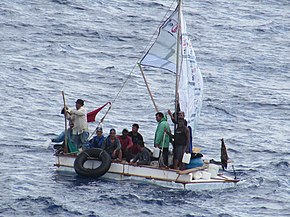Balseros

Balseros (Rafters, from the Spanish Balsa Raft) was the name given to boat people who emigrated without formal documentation in self constructed or precarious vessels from Cuba to neighboring states including The Bahamas, Jamaica, the Cayman Islands and, most commonly, the United States since the 1994 Balsero crisis and during the wet feet, dry feet policy.
History[]
1994 Cuban rafter crisis[]
The August 1994 Cuban rafter crisis was the fourth wave of Cuban immigration following Castro's rise to power.[1] The 1994 Balseros Crisis was ended by the agreement of the wet feet, dry feet policy between Bill Clinton and Fidel Castro.
During the 1994 Cuban Rafter Crisis, the most commonly observed raft from the US tanker Coastal New York was constructed of 2 doors atop large truck-tire inner tubes, with the doors connected by 2"x4" wooden beams. A rudimentary 2-3m mast was improvised that supported a small white cloth as a flag or banner that would increase the raft's visibility to vessels traveling nearby. The Coastal New York observed over 75 abandoned rafts in a 4-hour daylight period near the Gulf Stream off Florida's east coast. All the abandoned rafts had been marked with fluorescent orange paint, presumably marked by USCG personnel involved in rescue/recovery operations.[2]
Wet feet, dry feet policy[]
After 1994 balseros continued to arrive in the United States from Cuba. In the 2015 fiscal year, 4,473 balseros attempted to come to the United States. In fiscal year 2016, the number was 7,411. In January 2017 the Wet feet, dry feet policy came to an end, and now any balsero can be subject to deportation. Shortly before the policy ended the U.S. Coast Guard noticed a spike in balseros attempting to reach the United States.[3]
After 2017[]
Since the end of the Wet feet, dry feet policy in 2017, fewer balseros attempted to make the journey to the United States. Some still continue to come with less legal support. If they manage to arrive in Florida the only legal way to remain is to apply for political asylum.[4]
Emigration[]
Often the boats created are unsafe, and utilize engines not often used for boats such as lawnmower engines. Of those that choose to emigrate by raft, some are captured by Cuban authorities, others arrive safely outside Cuba, some are intercepted by United States authorities and given medical care only to be returned to Cuba, while others may be lost at sea and their deaths will go unreported.[5]
Deaths[]
It is estimated 16,000 to 100,000 Balseros perished at sea in their flight away from Cuba.[6]
See also[]
- Cuban boat people
- Marielitos
- Wet feet, dry feet policy
- Balseros – the title of a 2002 documentary about those persons and their experiences in Cuba and in the United States.
References[]
- ^ HISPANIC AMERICAN RELIGIOUS CULTURES 2 VOLUME SET Key West, New Orleans, and New York City before 1959, the vast majority of Cuban Americans trace their U.S. residency or birth to four successive waves of immigration after 1960. ... The second wave began in 1965 and ended in 1973."Finally, the Balsero (Cuban Rafters) Crisis of 1994 almost became a repeat of the 1980 Mariel Exodus as some people stormed foreign embassies in Cuba, while thousands of others attempted to flee the island on makeshift rafts and unsafe ..That summer, over a four-day period in late August, a fleet of 16 Coast Guard cutters picked up over 8,000 Cuban rafters. ... Some scholars identify this crisis as the fourth wave of Cuban immigration to the United States, while others interpret it as part of the smaller ... Although the Cuban Rafter Crisis of 1994 was settled by an agreement between Fidel Castro and President William Clinton, the balsero"
- ^ https://www.dailysignal.com/2015/01/16/cubans-risked-escape-communism-see-sailed-america/
- ^ Diaz, Johnny (20 January 2017). "Cuban rafts a symbol of escape". Sun Sentinel.
- ^ Penton, Mario (29 January 2020). "Cubans are still arriving in Miami aboard rafts and speed boats". Miami Herald.
- ^ Gomez, Alan (16 July 2015). "Cuban rafters face treacherous journey to reach U.S." USA Today.
- ^ Ackerman, Holly (1996), "The Balsero Phenomenon, 1991–1994", Cuban Studies, 26: 169–200, JSTOR 24487714
External links[]
- University of Miami's site: The Cuban Rafter Phenomenon: A Unique Sea Exodus.
- Cuban-American history
- Cuba–United States relations
- Immigration to the United States
- Rafting
- Cuban refugees
